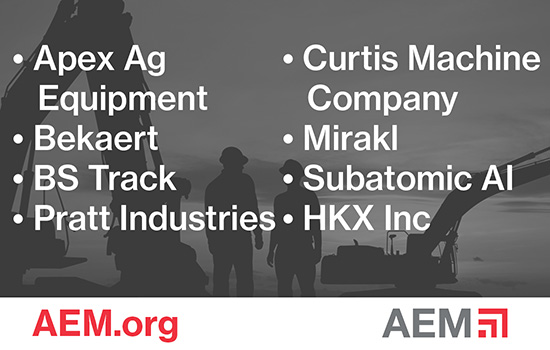AEM has been participating in the creation of standards since 1968. Yet a lot of people, including many AEM member company representatives, have a lot of questions about what types of standards exist, who creates them, how they are created, and how they can get involved.
At the same time, a lot of people have a lot of questions about a key area of innovation today: machine autonomy. What types of autonomous solutions are being developed? What types of requirements should manufacturers be considering?
“We wanted to put a single source of information together that would allow people to get the answers to those types of questions,” said Joe Flaugher, manager of product safety standards at AEM member company John Deere. “A lot of our efforts as industry are put into industry standards, and standards development and autonomy go hand in hand today.”
The “single source of information” Flaugher is referring to is AEM’s recently published whitepaper, Standards Development – Autonomy. As a current and very involved member of AEM’s Autonomous Machines Coordinating Committee, Flaugher was instrumental in the development of that whitepaper. He currently serves as chair of AEM’s Technology Innovation Council.
Sam Rathburn, technical manager for Safety & Product Leadership at AEM, was also heavily involved in the development of the autonomy standards whitepaper.
“The standards process is universal,” Rathburn pointed out. “This paper captures the unique content-specific topic of autonomy. When we created this document, we were intentional in creating something we could use as a template that could shift from autonomy to AI, engine emissions, PFAS, or any another important topic.”
Flaugher and Rathburn discussed the contents of this new whitepaper during an AEM Member Education Webinar on May 28. What follows are highlights from the webinar.
Fundamentals of Standards
According to Flaugher, it was important to begin the whitepaper by first defining what a standard even is. A standard is an engineering specification that defines materials, products, processes, tests, test procedures, and performance criteria to achieve a specified purpose.
Flaugher said it’s surprising that so many people have no idea that standards exist for a multitude of everyday items. They also don’t realize the benefits a standard provides. That’s why AEM has made this whitepaper available to the general public through the Insights tab at the AEM website.
Once people gain an understanding of what a standard is, they often wonder how a standard differs from a law or regulation.
“One of the big differences is the bodies that write standards and regulations,” Rathburn pointed out.
Laws and regulations, for instance, are crafted by government legislative bodies and agencies.
“Standards, on the other hand, come from standards development organizations at the national level,” Flaugher added. “There are also international standards organizations that work through the various national groups to draft and publish international standards represented by all the different countries.”
Once a standard is published, it provides value to those who want to use it, such as a manufacturer that wants to make sure its products are compliant with the latest standards for that type of product. Sometimes lawmakers and regulators also make use of standards.
“Standards and regulations often become interconnected,” Flaugher said. “When people are writing regulations, they often lack the experts needed to write requirements around things like products. That can lead to unrealistic requirements. Governments can look to industry standards to either utilize them directly in the content of a regulation, or reference a standard directly if it contains all the information they want to have in the rules.”
Flaugher pointed to additional benefits of standards, such as the establishment of minimum requirements regarding product quality, safety, and compatibility, and the establishment of test procedures to allow customers to evaluate products. Several specific examples are provided in the whitepaper.
Another added benefit of standards pertains to legal proceedings when someone is seeking compensation for an issue they had with a product.
“If a product isn’t regulated by the government, it just falls under normal product liability,” Flaugher explained. “Industry standards can help manufacturers defend their products when they can provide confidence that they’ve met or exceeded the minimum requirement of those standards.”
Standards Development Process
Standards development involves numerous organizations that play specific roles, including ANSI, ASABE, ASTM, ASME, IEEE, and others. It’s all explained in detail in the whitepaper.
“The main takeaway is that there is a well-defined and regulated process for how standards are developed to help ensure openness, balance of interests, and proper expert input,” Flaugher said. “Another key takeaway is that the process takes a tremendous amount of work and collaboration between companies, organizations, and even specific people in order to reach consensus on the content of a standard so it can be published.”
The whitepaper also explains how individuals can get involved with the standards development process. The first step is getting in touch with the appropriate national standards development body. In the U.S., that is ANSI. In Canada, it’s the SCC (Standards Council of Canada).
“That might feel a little intimidating,” Flaugher said. “I can tell you from experience that they welcome hearing from anybody who wants to be involved. Once you take this first step, a whole world opens up. You become more aware of what is going on both nationally and internationally. You can also begin getting yourself integrated into some of the working groups to start contributing to the standards development process.”
AEM has numerous technical committees and working groups. One of them, the Autonomous Machines Coordinating Committee, is the technical committee that gave birth to the autonomy standards whitepaper. Rathburn said there is always a desire for more experts at the table—at AEM or ISO.
“We want to involve as many people as possible, because we want as much expertise involved in the process as possible,” Flaugher said.
Current State of Autonomy-Specific Standards
The whitepaper also outlines all of the key standards that have already been published in the area of machine autonomy, along with several that are still in the development process.
“It seems hard to believe, but there has been an auto-guidance safety standard for agriculture machinery and tractors for about 15 years now,” Flaugher said in reference to ISO 10975. “We’ve also recently published a whole series of safety standards around partially automated, semi-autonomous, and autonomous machinery. That’s been our entry into this discussion, and there’s a lot more coming.”
There have also been several key autonomy-related standards published around different aspects of earth-moving machinery and mobile road construction machinery. And as outlined in the whitepaper, numerous additional standards are in development pertaining to automated mining systems, dairy and livestock machinery, and other equipment types.
“When I looked at the list of in-progress standards in preparation for this webinar, I noticed that some have now been published,” Flaugher said. “We’ll be periodically updating this whitepaper to keep abreast of all the new things going and as different standards make their way to publication. Machine autonomy is a very active area of standards development right now.”
To get involved, visit AEM’s Autonomous Machines Coordinating Committee or contact AEM’s Sam Rathburn at srathburn@aem.org.





